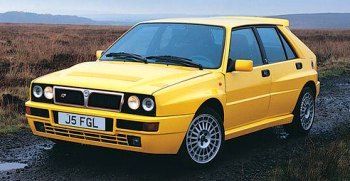 Evolution II The story of Delta can be traced back to 1979, when the production Delta debuted. Despite of its Giugiaro design and victory in European Car of the Year election, frankly speaking, that car was no more than a conventional family hatchback. It followed the class norm by using transverse powertrain, front-wheel drive and MacPherson strut suspension at each corner. It made no technological breakthrough, nor set any new class standards. Strangely, the Delta would not attain a classic status until seven years later... Like good wine, the older the better. By 1984, Lancia turbocharged its 1.6-liter motor to 130hp and created Delta turbo (later evolved to 140hp turbo i.e.). It became the highlight of the series, but still lacked the sparkle to revive Lancia's dynamic image dated back to the years of Fulvia and Stratos. Meanwhile, Lancia's contender in WRC was the fearsome Delta S4, specially built to Group B standard and had no relationship with the production Delta range, of course. 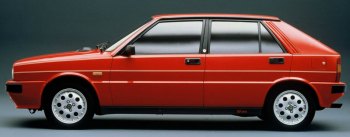 HF 4WD Things changed suddenly in 1986. Lancia's WRC campaign came to a turning point when Henri Toivonen crashed and died in his Delta S4. Fearing Group B cars for too fast and powerful, the motorsport governing body decided to terminate Group B at the end of that season. From 1987, WRC would be run with Group A cars, which demanded at least 5,000 production cars to be built for homologation. This effectively ruled out purpose-built rally cars (which Lancia had been using since Stratos) and required the race cars to be derived from mass production cars. Coincidence or not, at the very same time Lancia had completed the production Delta HF 4WD for sale. Its 4WD system followed the school of Delta S4 - a Ferguson epicyclic center differential was employed to distribute 56:44 power front to rear in normal driving condition. This was backed up by a viscous-coupling to lock up the center differential in case of wheel spin. The front axle had an open differential, while the rear axle employed a Torsen limited slip differential. Beside drivetrain, the HF 4WD had its engine upgraded to the same specifications of Thema turbo i.e. - 165hp 2.0-liter turbo. It was a further development from FIAT twin-cam, added with a Garrett T2 turbocharger and twin-balancer shafts to reduce vibration. Autocar magazine found the car fast and fun to drive. It was capable of 128 mph and took only 6.4 seconds to sprint from zero to sixty. At a time when rivals were hit by the dramatic change of regulations, Lancia Delta HF 4WD dominated the first year of Group A WRC, winning 9 out of 13 rounds, taking both manufacturer and driver championship with ease. 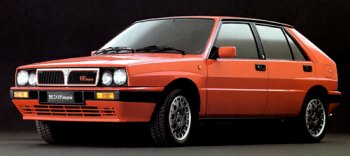 Integrale That was only the beginning. Next year, the car was developed into HF Integrale in order to enhance its competitiveness in world rallying. The first Integrale was distinguishable by widened wheel arches (like Audi Quattro), which housed wider and larger diameter rubbers. Its engine was heavily reworked to deliver 185 horsepower, thanks to a larger Garrett T3 turbo, larger intercooler, new valves and improved cooling etc. Brakes and suspensions were also beefed up. Autocar magazine found it was only marginally quicker than the previous car, but it declared the car a better drive than the mighty Audi Quattro. In particular, the Delta was praised for razor-sharp steering, outstanding agility and better grip on slippery surfaces, therefore a better car to attack twisty mountain roads. Bear in mind that the Delta cost just half the price of Quattro ! Integrale was found to be a huge success. In WRC, it swept the first three places of the 1988 driver standing and retained the manufacturer title in 1988 and 1989. In commercial side, its sales accumulated to nearly 10,000 units in two years, doubling the number required for homologation. This must made Ford Escort RS Cosworth and Toyota Celica GT4 envied ! 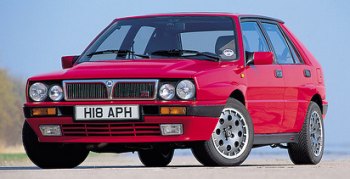 Integrale 16V 1989 saw the upgrade to Integrale 16V. Highlight was the new 16-valve head, which demanded a power bulge on the bonnet. The wheel arches were widened slightly (though not easy to spot), accompanied with wider tires again. The Garrett T3 got smaller turbine to reduce lag. Output increased to a full 200 horses. Though peak torque was reduced by 4 lb-ft to 220 lb-ft, it arrived 500 rpm earlier. The 4WD had torque split revised to slightly rearward-biased (47:53) in order to reduce understeer - Juha Kankkunen and Miki Biasion must preferred that. Stiffer suspensions improved body control and steering response. ABS was added for the first time. Nevertheless, the 16V was described by Autocar as more difficult to drive than Integrale 8V. Its ride was coarser, its behaviour at the limit was edgier, easier to oversteer. It was faster again from A to B, but it demanded more from the driver. As the aging Delta was increasingly challenged by Toyota (whose driver Carlos Sainz stole two driver titles from Lancia), it was modified again in 1991. The Integrale Evolution focused on improving handling. Suspensions were beefed up with wider tracks (54 and 60mm up front and rear respectively), revised geometry and longer travel. Steering and brakes were also altered. Outside, wider flared wheel arches concealed the wider tracks. The engine got a boost of 10 horsepower, thanks to new ECU, to offset the slight increase of weight and drag, so performance was basically unchanged. In fact, from HF 4WD to the last Integrale Evolution II, straight line performance was not much improved. The aging Delta fell behind its more powerful and aerodynamic efficient rivals like Celica GT4 and Impreza WRX. Nevertheless, the Integrale Evolution still managed to bring Delta the sixth manufacturer wins in 1992, allowing Lancia to bow out WRC in high. Even after its retirement from WRC, demand for the rally icon did not dry out immediately. Lancia therefore produced Integrale Evolution II, the only member of Integrale designed purely for road use. Its power got a slight increase by 5hp thanks to new engine management system. A smaller turbo reduced lag and improved low-end response. Larger wheels and more standard equipments completed the package. The Evolution II was not as swift as its predecessor at high rev, but it was more drivable as a road car. When the last car delivered in late 1994, the whole Delta Integrale series (including HF 4WD) accumulated to more than 40,000 units. It remains a legend today. 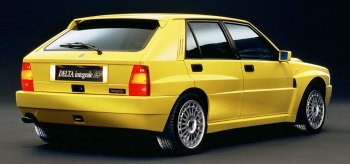 Evolution II |